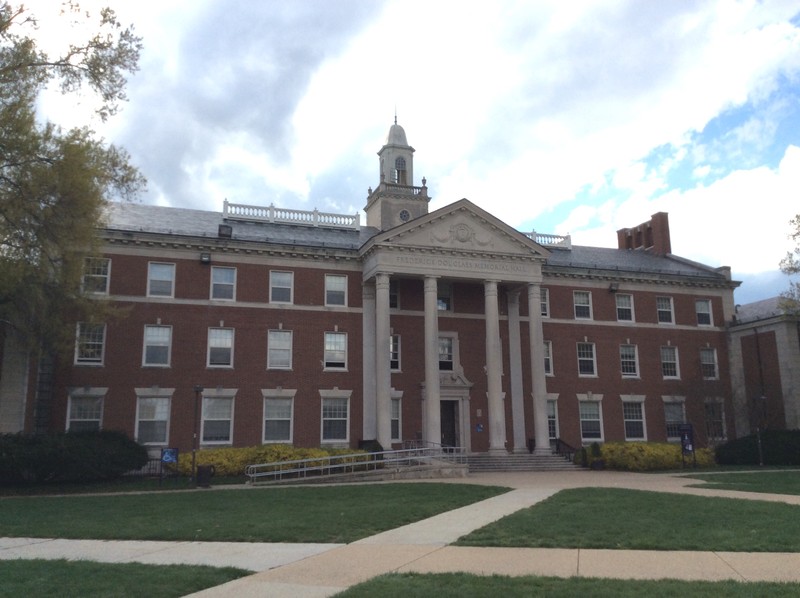Frederick Douglass Memorial Hall, Howard University
Introduction
Text-to-speech Audio
Images
Students sitting on the steps of the Frederick Douglass Memorial Hall, 1942

Exterior of the building as seen from the main quad

Backstory and Context
Text-to-speech Audio
Frederick Douglass was born as a slave in 1818, but was able to escape to New England after twenty years of bondage. Upon escaping to freedom, Douglass worked with prominent white abolitionist William Lloyd Garrison. Soon, Douglass became an even more powerful voice against slavery than his mentor and he became an influential member of the American Anti-Slavery Society (AASS). Douglass remained in this group even as it began to lose many of its Black members until deciding that he would be able to spread his message more effectively as an individual. He started publishing his own work in 1847.
Douglass became more radical in his beliefs, breaking with many leading white abolitionists such as Garrison that refused to consider the use of violence to end slavery. Douglass had endured violence while a slave and this experience and the success of several rebel slaves and runways led Douglass to consider the need to use any means to liberate oneself from bondage. Although there were notable exceptions such as John Brown, white abolitionists typically counseled patience and the use of moral suasion or political action. While Douglass and other Black abolitionists also utilized these tactics, they refused to condemn African Americans who had liberated themselves by any means necessary.
Douglass was a member of the Board of Trustees at Howard from 1871-1895. This building was dedicated in 1935 and designed by African American architect Albert Cassell. Cassell designed the building after joining Howard as a professor in the Architecture Department in 1920. Over the course of 18 years, Cassell contributed other designs and helped expand Howard’s campus by working to purchase land and begin new construction. Cassell worked on nine different buildings, three of which are considered among the most important and notable on campus today: the Chemistry Building, Founders Library, and Frederick Douglass Memorial Hall.
The building contains numerous classrooms and houses the Departments of Political Science, Sociology and Anthropology, History, and the R.O.T.C. Program. Over the years, it has also been a home for the Departments of Education and Psychology as well as the Deans of the College of Liberal Arts and the Graduate School. It is located in the main yard of the university along with the Founders Library and other notable buildings.
Howard University was founded in 1867 and remains one of the premiere historically Black colleges and universities (HBCUs). Named after Civil War General Oliver Otis Howard, the school was founded to train teachers and ministers and evolved to include a variety of other courses and programs that allowed students of color the opportunity to pursue higher education. Howard established the first Black law school soon after its conception and trained may of the attorneys that challenged discriminatory laws in the 20th century. Howard graduates include some of the most successful civil rights lawyers such as Thurgood Marshall, whose work led to the NAACP's victory in Brown vs Board in 1954.
Sources
2Lowe, Turkiya L. Historic Landmark Nomination. Accessed September 20, 2017. https://www.howard.edu/library/development/HistoricLandmarkNom.pdf.
3Smith, Alonzo. Howard University (1867- ). BlackPast.org. Accessed September 20, 2017. http://www.Blackpast.org/aah/howard-university-1867.
